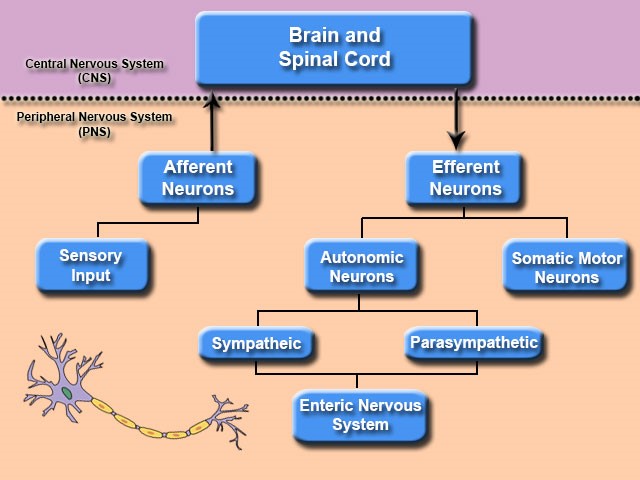Artlabeling Activity Schematic of Levels of Organization in the Nervous System
Introduction to the Nervous System
Imagine that y'all of a sudden lost the ability to stand unless you lot looked down at your anxiety. What if your artillery seemed to wander unless you lot kept an eye on them. This is the exact situation that Christina plant herself in later on waking up one morn. She exclaimed: "Something awful'south happened, I tin't feel my torso. I experience weird—disembodied." Essentially, overnight Christina had lost all proprioception: the ability to sense the relative position of body parts. This integral part of her nervous system had suddenly deteriorated. Because the sense of body positioning is determined by 3 things: vision, residual organs, and proprioception, which she had lost, Christina learned to control her trunk with her optics, but she found that she could do nothing without using her eyes. In fact her torso would plummet into a heap the minute she closed her eyes. Gradually over time Christina learned to walk again and to function with the usual business of life, but only with bang-up care in maintaining attending to the particular movement and never at the same level as before. She constitute that there was no in betwixt, or gradual change with movement. Strict focus had to exist maintained for even the simplest tasks. In her words, she states: "I experience my body is blind and deaf to itself ... it has no sense of itself" (Sacks, 1985). In this department you will acquire about the nervous system and how information technology controls the trunk, and perhaps more than importantly, as illustrated in Christina'due south case, how the nervous arrangement interprets the surround around us.
Organisation of the Nervous System
The nervous system coordinates voluntary and involuntary actions in the body by sending and receiving information. The nervous organisation is comprised of an enormous number of cells (over 100 billion), primarily of two types: neurons (the signaling units) and glial cells (the supporting units). Yet, nervous system office is mostly a story of the neuron. The neuron is the functional unit of the nervous organization and is designed to transmit data between cells. Interestingly, neurons with a particular function are plant in a predictable location. This regularity in structure has permitted neurobiologists to categorically organize the nervous system based on location and office (see effigy below).
Thus, the nervous arrangement can get-go exist divided into two major parts: the primal nervous system (CNS) and the peripheral nervous organisation (PNS). The CNS consists of neurons associated with key processing and which are located in the brain and spinal cord. The peripheral nervous arrangement (PNS) consists of neurons associated with sensory input (afferent) and motor output (efferent), and functions to connect the key nervous organization to all other parts of the body. Stated another way, if the entire structure of the neuron is independent inside the brain and/or spinal string, the neuron would be considered part of the CNS. In dissimilarity, if any part of the neuronal structure is located outside of the brain and/or spinal string the neuron would be considered part of the PNS (see prototype below).

Image generated at BYU-I S13
For the most part, data is transmitted between these two systems following this basic pattern: stimulus, receptor, afferent pathway (input signal), control center, efferent pathway (output signal), effector, and response. In other words, sensory receptors located throughout the body constantly monitor the weather of the environment and send this information via the PNS to the CNS for central processing. If a response is needed (i.e., to maintain homeostasis) the CNS will send new information through the PNS to target organs that will help accommodate to the initial stimulus. It should exist noted that some functions can be contained entirely within the CNS; for example, dreaming, thinking, or even data storage.

Image generated at BYU-I S13
Neurons of the efferent division of the PNS can be further subdivided into the somatic nervous system, which controls the voluntary movement of skeletal muscle and the autonomic nervous system which regulates involuntary functions of organs and tissues. Autonomic neurons are farther subdivided into sympathetic and parasympathetic systems (encounter first effigy). The autonomic nervous organisation volition be addressed in a split module.
A third division of the PNS is a semi-independent nervous system chosen the enteric nervous system which controls the gastrointestinal tract (run into start figure). This system is considered semi-contained because it can run independently, or through modulation past the autonomic nervous system. Information technology is also interesting to note that the enteric nervous organisation contains more than neurons than the entire spinal cord.
**Y'all may apply the buttons beneath to get to the adjacent or previous reading in this Module**

bergeronkelin1954.blogspot.com
Source: https://content.byui.edu/file/a236934c-3c60-4fe9-90aa-d343b3e3a640/1/module6/readings/intro_nerve_system.html
0 Response to "Artlabeling Activity Schematic of Levels of Organization in the Nervous System"
Post a Comment